People are definitely way more excited about neurogenesis in adulthood than in early development. Which is fine. But the emphasis on adult neurogenesis has exposed some gaps in our understanding of the developmental process and so we have embarked on a study to compare neurons born are these different stages of life.
Here are some pictures, hot off the press, showing the expression of phenotypic markers that are routinely used in studies of adult neurogenesis: DAPI (reveals cell nuclei), BrdU (reveals cells that were dividing at the time of BrdU injection, which in these images was postnatal day 6), DCX (reveals immature neurons) and NeuN (reveals neurons, with staining intensity being proportional to cellular maturity). These images span P6 (the peak of dentate gyrus development) all the way to 8 weeks of age (often considered early adulthood in the rat). You can see clear patterns, for example, where DCX decreases with age and NeuN increases with age. There are also gradients of the two proteins, illustrating where the older and younger neurons are located. All images were acquired on a Leica SP8 confocal microscope, with a 10x objective.
Some of the images are large, by web standards. We can provide highly compressed and pixelated images that are embedded into a pdf if you prefer.
- Postnatal day 6. BrdU injected 1 hour earlier. BrdU (green), DCX (red), NeuN (white), DAPI (blue).
- BrdU injected 24 hours earlier, on P6. BrdU (green), DCX (red), NeuN (white), DAPI (blue).
- BrdU injected 3 days earlier, on P6. BrdU (green), DCX (red), NeuN (white), DAPI (blue).
- BrdU injected 1 week earlier, on P6. BrdU (green), DCX (red), NeuN (white), DAPI (blue).
- BrdU injected 2 weeks earlier, on P6. BrdU (green), DCX (red), NeuN (white), DAPI (blue).
- BrdU injected 3 weeks earlier, on P6. BrdU (green), DCX (red), NeuN (white), DAPI (blue).
- BrdU injected 8 weeks earlier, on P6. BrdU (green), DCX (red), NeuN (white), DAPI (blue).
- 3 days post BrdU injection, broken into channels
- 3 weeks post BrdU injection, broken into channels
- 8 weeks post BrdU injection, broken into channels
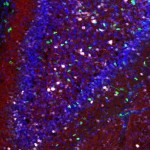
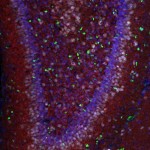
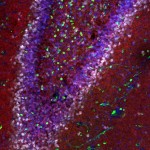
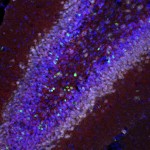
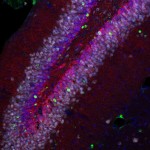
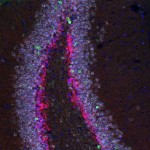
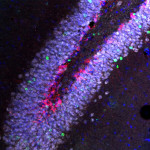
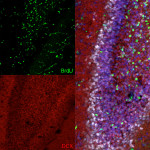
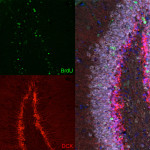
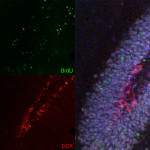
If I may- how many injections at what concentration of BrdU did you give to achieve this degree of staining?
Many thanks,
David
Hi David, We gave one injection of BrdU at postnatal day 6. The injections were 50mg/kg.
-Shaina
Hi,
Beautiful staining!
Would you mind sharing the BrdU/DCX double staining protocol and also the source of antibodies?
Many thanks.
Marta